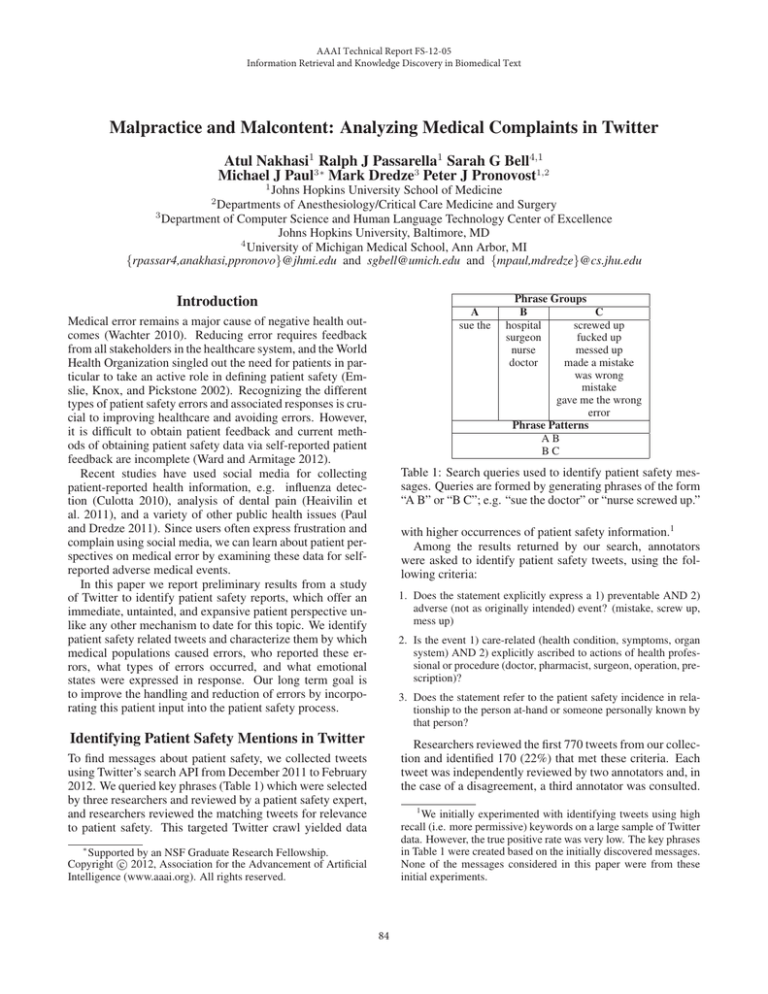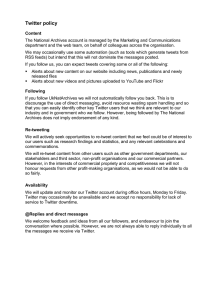
AAAI Technical Report FS-12-05
Information Retrieval and Knowledge Discovery in Biomedical Text
Malpractice and Malcontent: Analyzing Medical Complaints in Twitter
Atul Nakhasi1 Ralph J Passarella1 Sarah G Bell4,1
Michael J Paul3∗ Mark Dredze3 Peter J Pronovost1,2
1
Johns Hopkins University School of Medicine
Departments of Anesthesiology/Critical Care Medicine and Surgery
3
Department of Computer Science and Human Language Technology Center of Excellence
Johns Hopkins University, Baltimore, MD
4
University of Michigan Medical School, Ann Arbor, MI
{rpassar4,anakhasi,ppronovo}@jhmi.edu and sgbell@umich.edu and {mpaul,mdredze}@cs.jhu.edu
2
Introduction
A
sue the
Medical error remains a major cause of negative health outcomes (Wachter 2010). Reducing error requires feedback
from all stakeholders in the healthcare system, and the World
Health Organization singled out the need for patients in particular to take an active role in defining patient safety (Emslie, Knox, and Pickstone 2002). Recognizing the different
types of patient safety errors and associated responses is crucial to improving healthcare and avoiding errors. However,
it is difficult to obtain patient feedback and current methods of obtaining patient safety data via self-reported patient
feedback are incomplete (Ward and Armitage 2012).
Recent studies have used social media for collecting
patient-reported health information, e.g. influenza detection (Culotta 2010), analysis of dental pain (Heaivilin et
al. 2011), and a variety of other public health issues (Paul
and Dredze 2011). Since users often express frustration and
complain using social media, we can learn about patient perspectives on medical error by examining these data for selfreported adverse medical events.
In this paper we report preliminary results from a study
of Twitter to identify patient safety reports, which offer an
immediate, untainted, and expansive patient perspective unlike any other mechanism to date for this topic. We identify
patient safety related tweets and characterize them by which
medical populations caused errors, who reported these errors, what types of errors occurred, and what emotional
states were expressed in response. Our long term goal is
to improve the handling and reduction of errors by incorporating this patient input into the patient safety process.
Phrase Groups
B
C
hospital
screwed up
surgeon
fucked up
nurse
messed up
doctor
made a mistake
was wrong
mistake
gave me the wrong
error
Phrase Patterns
AB
BC
Table 1: Search queries used to identify patient safety messages. Queries are formed by generating phrases of the form
“A B” or “B C”; e.g. “sue the doctor” or “nurse screwed up.”
with higher occurrences of patient safety information.1
Among the results returned by our search, annotators
were asked to identify patient safety tweets, using the following criteria:
1. Does the statement explicitly express a 1) preventable AND 2)
adverse (not as originally intended) event? (mistake, screw up,
mess up)
2. Is the event 1) care-related (health condition, symptoms, organ
system) AND 2) explicitly ascribed to actions of health professional or procedure (doctor, pharmacist, surgeon, operation, prescription)?
3. Does the statement refer to the patient safety incidence in relationship to the person at-hand or someone personally known by
that person?
Identifying Patient Safety Mentions in Twitter
Researchers reviewed the first 770 tweets from our collection and identified 170 (22%) that met these criteria. Each
tweet was independently reviewed by two annotators and, in
the case of a disagreement, a third annotator was consulted.
To find messages about patient safety, we collected tweets
using Twitter’s search API from December 2011 to February
2012. We queried key phrases (Table 1) which were selected
by three researchers and reviewed by a patient safety expert,
and researchers reviewed the matching tweets for relevance
to patient safety. This targeted Twitter crawl yielded data
1
We initially experimented with identifying tweets using high
recall (i.e. more permissive) keywords on a large sample of Twitter
data. However, the true positive rate was very low. The key phrases
in Table 1 were created based on the initially discovered messages.
None of the messages considered in this paper were from these
initial experiments.
∗
Supported by an NSF Graduate Research Fellowship.
c 2012, Association for the Advancement of Artificial
Copyright Intelligence (www.aaai.org). All rights reserved.
84
Reported By
Patient
Relative
Friend
Colleague
Other Patient
Medical
Unknown
Percentage
80.6%
8.0%
1.1%
0.0%
2.3%
0.0%
8.0%
Error Source
Surgeon
Doctor
Nurse
Pharmacist
Other Medical
Dentist
Unknown
Percentage
18.1%
51.5%
18.7%
0.0%
4.7%
0.0%
7.0%
Error Type
Surgical
Diagnostic
Medication
Procedure
Infection
Communication
Unknown
Percentage
7.2%
15.0%
22.2%
36.5%
0.0%
9.6%
9.6%
Error Emotion
Unknown
Anger
Humor
Sadness
Relief
Disbelief
Prayer
Percentage
47.1%
22.2%
10.5%
5.9%
6.5%
7.8%
0.0%
Table 2: The distribution of the source of the error mention (i.e. the Twitter user), the source of the error, the error type, and the
error response (i.e. the emotion associated with the error mention).
Additionally, identified tweets were categorized by reporter
role, error source, error type, and response type.
Our study also found that patients and relatives reacted
to safety errors in a wide variety of manners. While some
patients expressed anger and frustration in response to errors, others found the errors humorous and had an easy time
moving on from them or used humor as a potentially effective coping mechanism for errors. A small portion of the
tweets (7%) cited malpractice as a possible outcome for the
error. It is important to understand why patients and their
families exhibit these different emotions and how these responses can be better communicated between patients and
their families and health care professionals. For example,
new healthcare training to target emotional interactions between patients and health care professionals could decrease
the number of disgruntled patients and families that suffered
a safety error. Since errors were self-reported and reported
via family members, it is important to differentiate between
the various emotional responses to determine how to ensure
all members of the patients team are aware of the error and
satisfied with the health care response to the error.
While the implications for patient safety are exciting, this
work has some limitations. First, the Twitter user population, or the population writing about medical errors, may
not be representative of the general population. Additionally, our techniques so far have only yielded a limited number of patient safety messages. As of yet, we do not know
if these limitations are inherent to the data or our collection
and analysis methods. Our next steps will include further
quantitative analysis to assess Twitter’s utility as a source
for patient safety events and patient-generated data.
Results and Analysis
Of the 170 identified patient safety tweets, 81% were selfreported, 9% were reported by a family member or friend,
and 10% were reported by a third-party source (i.e., colleague, another patient, medical provider) or an unknown
source. The most frequently stated error type was procedural
error (37%) followed by medication error (22%). Physicians
were identified as the error source most frequently (51%)
followed by nurses (19%) and surgeons (18%). Most users
did not state their life response (i.e. intended follow-up) to
the adverse event, however, 7% stated intent to sue a hospital or provider.2 Table 2 summarizes the results. Examples
of the types of tweets analyzed in our study include:
• The nurse messed up so now she gotta draw more of his
blood. Smh
• One of my residents was admitted to die because a surgeon messed up on her back surgery and she’s only 43.
• REALLY?! my doctor screwed up my prescription... I’ve
been taking the wrong dosage for almost a year. HMM.
MAYBE THAT EXPLAINS SOMETHING.
These tweets highlight a procedural error by a nurse with
an emotional disbelief (smh = shaking my head); a surgical
procedure error expressed by third-party; and a physician
prescription error that lasted over a year. What is evidenced
by this is that patients are expressing their patient safety experiences on Twitter. Capturing these patient perspectives
can fuel a new era of patient-centered improvements.
References
Culotta, A. 2010. Towards detecting influenza epidemics by analyzing twitter messages. In Workshop on Social Media Analytics.
Emslie, S.; Knox, K.; and Pickstone, M., eds. 2002. Improving
Patient Safety: Insights from American, Australian, and British
healthcare. Emergency Care Research Institutue Europe.
Heaivilin, N.; Gerbert, B.; Page, J. E.; and Gibbs, J. L. 2011.
Public health surveillance of dental pain via Twitter. Journal of
dental research 90(9):1047–1051.
Paul, M. J., and Dredze, M. 2011. You are what you tweet: Analyzing twitter for public health. In International Conference on
Weblogs and Social Media (ICWSM).
Wachter, R. M. 2010. Patient safety at ten: Unmistakable progress,
troubling gaps. Health Affairs 29(1):165–173.
Ward, J. K., and Armitage, G. 2012. Can patients report patient
safety incidents in a hospital setting? A systematic review. BMJ
Quality & Safety.
Discussion
Our study found that patient safety events are primarily selfreported or relative-reported, demonstrating the potential for
learning patient perspectives from Twitter. Additionally, we
were surprised to find many serious errors (e.g. surgical),
some of which the user said could result in death. Since
most patient safety strategies revolve around physicians and
surgeons, these Twitter data could bring a unique patient
perspective to the errors caused by nurses, physicians and
other health care team members. Future studies will examine strategies for entire health care teams to improve patient
safety based on this unique patient perspective.
2
We obviously cannot verify actual action or if the user intends
to actually pursue the action.
85





